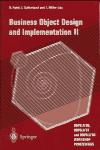An Interoperability
Approach for CCISs based on Business Objects and WorkFlows
Interoperability
Research Group
Information
System Technology Section
Defence
Research Establishment Valcartier
2459 Pie-XI
Blvd North, Val-Bélair QC, G3J 1X5, Canada
Abstract.
The paper introduces the concepts of
Business Objects (BOs) and WorkFlow (WFs) for the design and development of
interoperable environments. Interoperability is a process that allows
cooperative interactions between several systems. These systems are distributed
across networks and present incompatibilities at different levels (material,
software, and terminology). Our research is applied to the IC2IS project that aims
at developing an interoperable environment for Command & Control
Information Systems (CCISs). The use of a single CCIS seems “easy”. However,
the operation becomes much complex when several CCISs, generally distributed
and heterogeneous, are required. Therefore, we intend to set up BOs to support
the interoperability of these CCISs. Moreover, given the complexity of managing
such CCISs, we suggest specifying the operating mode of these BOs, using WFs.
Keywords. Interoperability, Business Objects, WorkFlows, CCIS.
 Patel , D., Sutherland, J., Miller, J., (Eds.) Business Object
Design and Implementation II: OOPSLA'99 Workshop Proceedings. Springer, 1999
(full text available at the Workshop).
Patel , D., Sutherland, J., Miller, J., (Eds.) Business Object
Design and Implementation II: OOPSLA'99 Workshop Proceedings. Springer, 1999
(full text available at the Workshop).
References
M. Baker. Workflow
meets business objects. In the proceedings of OOPSLA'96 Workshop, Business
Object Design and Implementation II: Business Objects as Distributed
Application Components - the enterprise solution? , 1996.
BOMA. Business Object
Management Group, http://www.sesh.com/Guide/BusinessObjects.html.
T. Cai, P. Gloor, and
S. Nog. Dartflow: A workflow management system on the web using transportable
agents. Technical report, PCS-TR96-283, Department of Computer Science,
Dartmouth College, Hanover, NH 03755, 1996.
D. Chess, G. Harrison,
and A. Kershenbaum. Mobile agents: Are they a good idea? Technical report, IBM
Research Division, RC 19887, 1994.
R. Davis and R.G.
Smith. Negotiation as a metaphor for distributed problem solving. Artificial Intelligence, 20:63--109,
1983.
P. Eeles and O. Sims. Building Business Objects. John Wiley,
1998.
D. Georgakopoulos, M.
Hornick, and A. Sheth. An overview of workflow management: From process
modeling to workflow automation infrastructure. Distributed and Parallel Database, 3:119-153, 1995.
T.R. Gruber and G.R.
Olsen. An ontology for engineering mathematics. In J. Doyle, P. Torasso, and E.
Sandewall, editors, the proceedings of
Fourth International Conference on Principles of Knowledge Representation and
Reasoning. Morgan Kaufmann, 1994.
P. Herzum and O. Sims.
The business component approach. In the
proceedings of OOPSLA'98 Workshop, Business Object Design and Implementation
IV: From Business Objects to Complex Adaptive System, Vancouver, Canada,
1998.
D. Jones, T.
Bench-Capon, and P. Visser. Methodologies for ontology development. In the proceedings of IT&KNOWS -
Information Technology and Knowledge Systems, 15th IFIP World Computer Congress.
Vienna (Austria) and Budapest (Bulgaria), 1998.
S. Malerud, Feet E.H.,
and U. Thorsen. A method for analysing command and control systems. Norwegian
Defence Research Establishment (FFI) N-220 Kjeller, Norway.
B. Moulin and M.
Brassard. A scenario-based design method and an environment for the development
of multiagent systems. In First
Australian Workshop on Distributed Artificial Intelligence, n. 1087, pages
216-231. D. Lukose, Zhang C. (edts.), Lecture
Notes in Artificial Intelligence, Springer-Verlag, 1996.
R. Orfali, D. Harkey,
and J. Edwards. The Essential Distributed
Objects Survival Guide. John Wiley & Sons, 1996.
A. Watson. The omg
after corba~2. Object Magazine, SIGS
Publication, pages 58-60, March 1996.